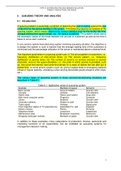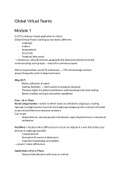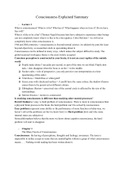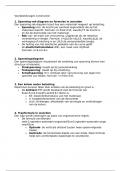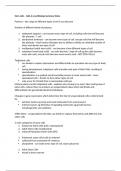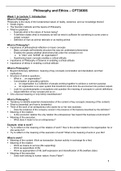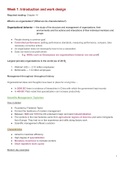PART III: SYSTEM ANALYSIS AND DESIGN EVALUATION
Chapter 6: Queuing Theory and Analysis
6 QUEUEING THEORY AND ANALYSIS
6.1 Introduction
A queuing problem is essentially a problem of balancing the cost of waiting against the cost
of idle time for the service facilities in the system. This balancing requires an analysis of the
queuing system, which means determining various statistics such as the facility idle time,
average waiting time, queue length, etc., for various conditions. The problem arises due to
the stochastic nature of the times between the arrivals of customers as well as the time it
takes to serve each customer.
In any service system/manufacturing system involving queueing situation, the objective is
to design the system in such a manner that the average waiting time of the customers is
minimized and the percentage utilization of the server is maintained above a desired level.
The important parameters in a queuing system are: (i) The arrival pattern of customers, i.e.,
frequency distribution of inter-arrival times; (ii) The service pattern, i.e., frequency
distribution of service times; (iii) The number of servers (or service counters or service
channels); and (iv) the queue discipline, i.e., the order in which service is provided, such
as, first-come-first-served, last-come-first-served (in a stack of dishes the last dish put is
picked first), or some priority system (such as, giving hospital beds to emergency patients
ahead of regular patients, unloading a ship carrying perishable goods ahead of other ships,
etc.).
The various types of queueing system in many service/manufacturing situations are
described in Table 6.1.
Table 6.1: Application areas of queueing system
Example Members of queue Server(s)
Bank counter Account holders Counter clerk
Toll gate Vehicles Toll collectors
Ration shop Ration card holders Shop clerk
Main frame computer centre Programs Computer
Library Students Counter clerk
University cafeteria Student or staff Counter clerk
Traffic signal Vehicles Signal point
Final inspection station of TV assembly line Assembled TV. sets Inspector
Airport runways Planes Runways
Telephone booth Customers Telephones
Maintenance shop Breakdown machines Mechanics
Shopping mall/super markets Members of public Counter clerk
In addition to these examples, many subsystems of production, finance, personnel and
marketing functions of an organization can be modelled as queueing systems for
management decision making.
1
, PART III: SYSTEM ANALYSIS AND DESIGN EVALUATION
Chapter 6: Queuing Theory and Analysis
6.2 Terminologies of Queueing System
A schematic representation of a simple queueing system that consists of a queue and a
service station is shown in Figure 6.1.
Figure 6.1: Queueing system.
Customers who come to the system to get the required service will directly enter the service
station without waiting in the queue if the server is free at that point of time. Otherwise, they
will wait in the queue till the server becomes free. But in reality, there may be variations of
the system as given below.
1. The number of queues may be more than one. If there is a queue for male as well as
for female customers, then generally, alternate mode of selecting customers from each
queue is followed.
2. The number of servers may be more than one. This is an example of parallel counters
for providing service.
3. Sometimes, the service may be provided in multi-stages in sequential order. This type
of system is known as queues in tandem.
Bulk arrival. Generally, it is assumed that the customers arrive into the system one by one.
But, in' some reality, customers may arrive in groups. Such arrival is called as bulk arrival.
Jockeying. If there is more than one queue, the customers from one queue will be tempted
to join another queue because of its smaller size. This behaviour of the customers is known
as queue jockeying.
Balking. If the queue length appears very large to a customer he/she may not join the
queue. This property is known as balking of customers.
Reneging. Sometimes, a customer who is already in the queue will leave the queue in
anticipation of longer waiting time. This kind of departure from the queue without receiving
the service is known as reneging.
The list of variables which is used in queueing models is presented below:
n Number of customers in the system
C Number of servers in the system
pn(t) Probability of having n customers in the system at time t
pn Steady-state probability of having n customers in the system
P0 Probability of having 0 customer in the system
Lq Average number of customers waiting in the queue
Ls Average number of customers waiting in the system (in the queue and in the
service station)
Wq Average waiting time of customers in the queue
Ws Average waiting time of customers in the system (in the queue and in the service
station)
2
, PART III: SYSTEM ANALYSIS AND DESIGN EVALUATION
Chapter 6: Queuing Theory and Analysis
Arrival rate of customers
Utilization factor of the server
µ Service rate of the server
eff Effective arrival rate of customers
M Poisson distribution
N Maximum number of customers permitted in the system. Also, it denotes the size
of the calling source of the customers
GD General discipline for service. This may be first-in-first-serve (FIFS), last-in-first-
serve (LIFS), random order (RO), etc.
6.3 Governing Equations for a Single-Server Queuing System
Assume that the population of units that may demand service is infinite with the number of
arrivals per period a random variable with a Poisson distribution. It is also assumed that the
time required to service each unit is a random variable with an exponential distribution.
Events are recognized to have occurred at the time of arrival of a unit or at the time of
completion of a service.
The expected number of arrivals per period may be expressed as , and the expected
number of service completions per period may be expressed as .
Probability of n Units in the System
Under the foregoing assumptions, the probability that an arrival occurs between the time t
and time t + t is t. Similarly, the probability that a service completion occurs between
time t and time t + t, given that a unit is being serviced at time t, is t. Let;
n = number of units in the system at time t, including the unit being served, if any
pn(t) = probability of n units in the system at time t.
Because the time interval t is small, it can be assumed that the probability of more than
one arrival or service completion during the interval is negligible. Consider the event that
there are n units in the system at time t + t with n ≥ 1 expressed as;
Event {n units in the system at time t + t}
= Event {n units in the system at time t, no arrivals during interval t, and no service
completions during interval t}, or
Event {n + 1 units in the system at time t, no arrivals during interval t, and one service
completion during interval t}, or
Event {n – 1 units in the system at time t, one arrival during interval t, and no service
completion during interval t}
The probability of the event n units in the system at time t + t can be written as the sum of
the probabilities of these three mutually exclusive events as;
pn(t + t) = {pn(t)[1 – t][1 – t]} + {pn+1(t)[1 – t] t} + {pn-1(t) t[1 – t]}
= pn(t) – ( + ) pn(t) t + pn(t)(t)2 + pn+1(t)(t) – pn+1(t)(t)2
+ pn-1(t) (t) – pn-1(t) (t)2 (6.1)
Terms involving (t)2 can be neglected. Subtracting pn(t) from both sides and dividing by t
yields
3
Chapter 6: Queuing Theory and Analysis
6 QUEUEING THEORY AND ANALYSIS
6.1 Introduction
A queuing problem is essentially a problem of balancing the cost of waiting against the cost
of idle time for the service facilities in the system. This balancing requires an analysis of the
queuing system, which means determining various statistics such as the facility idle time,
average waiting time, queue length, etc., for various conditions. The problem arises due to
the stochastic nature of the times between the arrivals of customers as well as the time it
takes to serve each customer.
In any service system/manufacturing system involving queueing situation, the objective is
to design the system in such a manner that the average waiting time of the customers is
minimized and the percentage utilization of the server is maintained above a desired level.
The important parameters in a queuing system are: (i) The arrival pattern of customers, i.e.,
frequency distribution of inter-arrival times; (ii) The service pattern, i.e., frequency
distribution of service times; (iii) The number of servers (or service counters or service
channels); and (iv) the queue discipline, i.e., the order in which service is provided, such
as, first-come-first-served, last-come-first-served (in a stack of dishes the last dish put is
picked first), or some priority system (such as, giving hospital beds to emergency patients
ahead of regular patients, unloading a ship carrying perishable goods ahead of other ships,
etc.).
The various types of queueing system in many service/manufacturing situations are
described in Table 6.1.
Table 6.1: Application areas of queueing system
Example Members of queue Server(s)
Bank counter Account holders Counter clerk
Toll gate Vehicles Toll collectors
Ration shop Ration card holders Shop clerk
Main frame computer centre Programs Computer
Library Students Counter clerk
University cafeteria Student or staff Counter clerk
Traffic signal Vehicles Signal point
Final inspection station of TV assembly line Assembled TV. sets Inspector
Airport runways Planes Runways
Telephone booth Customers Telephones
Maintenance shop Breakdown machines Mechanics
Shopping mall/super markets Members of public Counter clerk
In addition to these examples, many subsystems of production, finance, personnel and
marketing functions of an organization can be modelled as queueing systems for
management decision making.
1
, PART III: SYSTEM ANALYSIS AND DESIGN EVALUATION
Chapter 6: Queuing Theory and Analysis
6.2 Terminologies of Queueing System
A schematic representation of a simple queueing system that consists of a queue and a
service station is shown in Figure 6.1.
Figure 6.1: Queueing system.
Customers who come to the system to get the required service will directly enter the service
station without waiting in the queue if the server is free at that point of time. Otherwise, they
will wait in the queue till the server becomes free. But in reality, there may be variations of
the system as given below.
1. The number of queues may be more than one. If there is a queue for male as well as
for female customers, then generally, alternate mode of selecting customers from each
queue is followed.
2. The number of servers may be more than one. This is an example of parallel counters
for providing service.
3. Sometimes, the service may be provided in multi-stages in sequential order. This type
of system is known as queues in tandem.
Bulk arrival. Generally, it is assumed that the customers arrive into the system one by one.
But, in' some reality, customers may arrive in groups. Such arrival is called as bulk arrival.
Jockeying. If there is more than one queue, the customers from one queue will be tempted
to join another queue because of its smaller size. This behaviour of the customers is known
as queue jockeying.
Balking. If the queue length appears very large to a customer he/she may not join the
queue. This property is known as balking of customers.
Reneging. Sometimes, a customer who is already in the queue will leave the queue in
anticipation of longer waiting time. This kind of departure from the queue without receiving
the service is known as reneging.
The list of variables which is used in queueing models is presented below:
n Number of customers in the system
C Number of servers in the system
pn(t) Probability of having n customers in the system at time t
pn Steady-state probability of having n customers in the system
P0 Probability of having 0 customer in the system
Lq Average number of customers waiting in the queue
Ls Average number of customers waiting in the system (in the queue and in the
service station)
Wq Average waiting time of customers in the queue
Ws Average waiting time of customers in the system (in the queue and in the service
station)
2
, PART III: SYSTEM ANALYSIS AND DESIGN EVALUATION
Chapter 6: Queuing Theory and Analysis
Arrival rate of customers
Utilization factor of the server
µ Service rate of the server
eff Effective arrival rate of customers
M Poisson distribution
N Maximum number of customers permitted in the system. Also, it denotes the size
of the calling source of the customers
GD General discipline for service. This may be first-in-first-serve (FIFS), last-in-first-
serve (LIFS), random order (RO), etc.
6.3 Governing Equations for a Single-Server Queuing System
Assume that the population of units that may demand service is infinite with the number of
arrivals per period a random variable with a Poisson distribution. It is also assumed that the
time required to service each unit is a random variable with an exponential distribution.
Events are recognized to have occurred at the time of arrival of a unit or at the time of
completion of a service.
The expected number of arrivals per period may be expressed as , and the expected
number of service completions per period may be expressed as .
Probability of n Units in the System
Under the foregoing assumptions, the probability that an arrival occurs between the time t
and time t + t is t. Similarly, the probability that a service completion occurs between
time t and time t + t, given that a unit is being serviced at time t, is t. Let;
n = number of units in the system at time t, including the unit being served, if any
pn(t) = probability of n units in the system at time t.
Because the time interval t is small, it can be assumed that the probability of more than
one arrival or service completion during the interval is negligible. Consider the event that
there are n units in the system at time t + t with n ≥ 1 expressed as;
Event {n units in the system at time t + t}
= Event {n units in the system at time t, no arrivals during interval t, and no service
completions during interval t}, or
Event {n + 1 units in the system at time t, no arrivals during interval t, and one service
completion during interval t}, or
Event {n – 1 units in the system at time t, one arrival during interval t, and no service
completion during interval t}
The probability of the event n units in the system at time t + t can be written as the sum of
the probabilities of these three mutually exclusive events as;
pn(t + t) = {pn(t)[1 – t][1 – t]} + {pn+1(t)[1 – t] t} + {pn-1(t) t[1 – t]}
= pn(t) – ( + ) pn(t) t + pn(t)(t)2 + pn+1(t)(t) – pn+1(t)(t)2
+ pn-1(t) (t) – pn-1(t) (t)2 (6.1)
Terms involving (t)2 can be neglected. Subtracting pn(t) from both sides and dividing by t
yields
3

